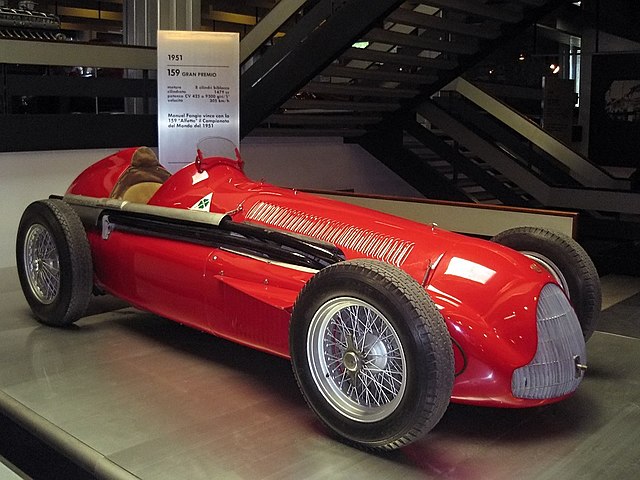Top Qs
Timeline
Chat
Perspective
Circuit des Nations
Street racing circuit From Wikipedia, the free encyclopedia
Remove ads
The Circuit des Nations ("Circuit of the Nations") was a street circuit between Lake Geneva and the Palais des Nations in Geneva, Switzerland. It hosted the Grand Prix de Nations, similar to a Formula One race; the Grand Prix de Genève, similar to a Formula Two race; and various championship events. The first Grand Prix de Genève was held in Meyrin in 1931 and won by Marcel Lehoux, racing for Bugatti.
Remove ads
Geneva race track (Switzerland)
Summarize
Perspective
The Geneva race track[1] was established in the 1930s between the lake (Geneva) and the Nations square following the closure of the nearby Circuit de Meyrin.
The circuit hosted some local motorcycling events before holding its first international event, the 1938 Swiss motorcycle Grand Prix.[2] Racing at the track was suspended during World War II and international competition resumed in 1946 when a number of Grand-Prix races on both two and four wheels were held on this track. In total, five major car races and four major motorcycle races happened on this track between 1938 and 1950.

The original length of the track for the 1938 event was stated as 2.800 km (1.740 mi).[2] Over the years small changes were made to the track layout until the track was significantly lengthened for the 1950 event by cutting out the hairpin on Avenue de France and replacing it by two long straits on both sides of Route de Lausanne, connected by a 180-degree hairpin.
Key pilots came here to compete, among them Giuseppe Farina, Raymond Sommer, Maurice Trintignant, Juan Manuel Fangio, Prince Bira (who had established residency, in Geneva).
The closest race tracks were Aix-les-Bains – France (Circuit du Lac) and Lausanne (Circuit du Léman or Blécherette). All were temporary urban race tracks that disappeared shortly after the Le Mans accident in 1955, or before.
Remove ads
1st Grand Prix des Nations
FIA Grand Prix, Circuit des Nations, Geneva, Switzerland – July 21, 1946
44 laps of the urban race track (short version) of 2.965 km (1.842 mi), or 130 km (81 mi), at an average speed of 103.9 km/h (64.6 mph).
Remove ads
2nd Grand Prix de Genève
FIA Formula 2, non-championship race, Circuit des Nations, Geneva, Switzerland – May 2, 1948
70 laps of the urban race track (short version) 2.945 km (1.830 mi), or 206 km (128 mi), at an average speed of 98.15 km/h (60.99 mph).[6]

2nd Grand Prix des Nations
FIA Formula 1, non-championship race, Circuit des Nations, Geneva, Switzerland – May 2, 1948
80 laps of the urban race track (short version) 2,945 m (1.830 mi) or 236 km (147 mi), at an average speed of 98.18 km/h (61.01 mph).

Remove ads
3rd Grand Prix de Genève
Summarize
Perspective
FIA Formula 2, non-championship race, Circuit des Nations, Geneva, Switzerland – July 30, 1950
45 laps of the urban race track 6,325 m (3.930 mi) or 253 km (157 mi), at an average speed of 120.93 km/h (75.14 mph).

Remove ads
3rd Grand Prix des Nations
FIA Formula 1, non-championship race, Circuit des Nations, Geneva, Switzerland – July 30, 1950
68 laps of the urban race track 6.325 km (3.930 mi) or 430 km (270 mi), at an average speed of 127.60 km/h (79.29 mph).

Remove ads
Swiss motorcycle Grand Prix winners by year
Source:[8]
Remove ads
Cancellation
Towards the end of the third Grand Prix des Nations (1950), the engine of Alberto Ascari's Ferrari 340 blew up, pouring oil onto the corner at the end of the Avenue de la Paix. Behind him Luigi Villoresi, in a Ferrari 275, could not avoid the oil, his car skidded, went over the security barrier and ploughed into the crowd. Three spectators were killed;[9] another twenty were injured. Villoresi survived with a severely fractured leg.
After this tragedy, stemming like others from the use of street circuits ill-adapted to increasingly high-speed motor racing, the organisers cancelled the following year's event. Geneva would never again host a Grand Prix race.
In 1958 motor racing was banned altogether by the Swiss government as an unsafe spectator sport following the death of 80 people at the 1955 24 Hours of Le Mans race.
Remove ads
References
Wikiwand - on
Seamless Wikipedia browsing. On steroids.
Remove ads

